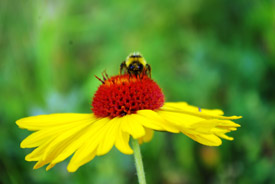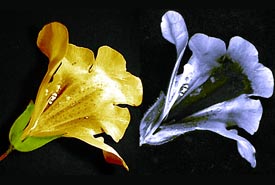What would insects think about #dressgate #thedress?

Bee on flower (Photo by NCC)
The #Dressgate colour craze is currently all over the online community and newspapers. For those who have yet caught on, there has been an eruption of arguments on social media over the true colours of a dress — blue and black, or white and gold — since yesterday. It turns out that we all see colours a little differently by the way our brain processes the image and that perception is affected by a number of factors such as age and lighting conditions.

Mimulus flower photographed in visible light (left) and ultraviolet light (right) showing a nectar guide visible to bees but not to humans. (Photo by Plantsurfer, Wikimedia Commons)
If such a variation exists within the human race, imagine what it is like to see the world in other species’ eyes! As this BBC News story reports, according to Professor Lars Chittka of Queen Mary’s School of Biological and Chemical Sciences, “the world we see is not the physical or the ‘real’ world — different animals have very different senses depending on the environment the animals operate in.”
So with so many varying opinions flying around the internet, and so many possible variations, we’ve decided to weigh in on #dressgate with an entomological perspective on this subject.
The sense of light — photoreception — plays an important role for various activities of an animal’s life such as finding mates, locating food and evading predators to name a few. For some insects like honey bees, detecting the polarization of light help them navigate. But what about colour? It turns out that most insects perceive wavelengths in the ultraviolet range of the spectrum.
If we could see flowers and plants through the eyes of a honey bee, we would see a world that’s very different from the field of brilliant colours we normally see. Most insects can discern the patterns on flowers and plants that are otherwise invisible to us using ultraviolet vision. These patterns act like landing strips that may take form of concentric circles or dots to attract the perfect pollinating agents.
So while most of us may be convinced that the dress is indeed blue and black (or gold and white...), the bees and insects would probably disagree!


